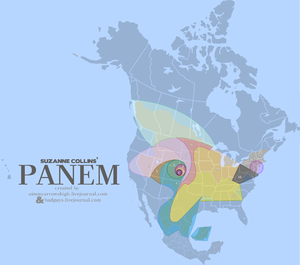
A good story sets the scene as a supporting character, as much as a necessary backdrop. Few stories are good stories. Most stories—like many of our modern lives—could take place anywhere, anytime. There is no ‘there’ there.
The Hunger Games, which reached the big screen in the U.S. this week, is a good story. Its the first of three good stories in the teen lit trilogy. Without giving away too much, the story concerns a future dystopia in which a totalitarian state has taken hold across North America, with 13 colonial districts beholden to the powerful Capital. After a rebellion by the districts, the 12 remaining are forced to send 2 youths as Tributes yearly to fight-to-the-death in a televised arena straight from the Roman colosseum.
[v=mfmrPu43DF8]
So we have, for Americans at least, the familiar political geography remade exotic. Clues are peppered throughout the trilogy as to the location of the Capital, and the location and industrial specialties of each district.
“In school, they tell us the Capitol was built in a place once called the Rockies. District 12 was in a region known as Appalachia. Even hundreds of years ago, they minded coal here.”
The scene is Appalachia, somewhere in the ashes of western Pennsylvania, West Virginia. I’ve never been to the mountains of North Carolina where the movie was shot, but it looks right. The heroine lives in District 12, a dirty, dreary place on the edge of the Capitol’s control. She begins her narrative early in the morning the day the Tributes are chosen:
“Our part of District 12, nicknamed the Seam, is usually crawling with coal miners heading out to the morning shift at this hour… But today the black cinder streets are empty.”
District 12 is a hungry place and suffers mostly benign neglect in the first book. It’s a small poor place, where distant laws are less important than the personal relationships between law enforcement and outlaws. And the Seam’s black market hosts a virtual Sherwood Forest of outlaws who survive on their wits and the bounty of the nearby wilderness. The the woods provide a safety release behind a poorly maintained barbed-wire electric fence. Who among us hasn’t wanted to just take off? To head for the hills and lead the problems of civilization behind? It’s out-of-bounds, but not really… and when the fence is fixed later in the series we know the political ante is raised. But I digress…
Our Tributes are spirited to the Capitol by high-speed rail. In this dystopia, humans have forgotten jet aviation (or we’ve screwed up the atmosphere so they don’t work anymore). There are hovercraft, but travel between the districts is forbidden. The train transports coal. And the high-speed Capitol trains transport dignitaries at 250 miles per hour. I’ve seen planner-types tweet “Cool, high-speed rail”, but I wonder if the author (intentionally or not) used trains as metaphor for the Capitol’s fascist control of the districts. There is no freedom, but the trains do run on time.
“What must it be like, I wonder, to live in a world where food appears at the press of a button? How would I spend the hours I now commit to combing the woods for sustenance if it were so easy to come by? What do they do all day, these people in the Capitol, besides decorating their bodies and waiting around for a new shipment of tributes to roll in and die for their entertainment?”
The Capitol, of course, is the exact opposite of the neglected districts. It is big and exciting and full of itself. The buildings are tall, the streets wide, and the residents narcissists extraordinare. In the movie in particular, the Capitol may as well be Berlin, 1939. I’ve always been uncomfortable with the political baggage of monumental architecture. Nothing here to allay my fears there.

Soon enough the 24 Tributes are thrown into the arena. Nobody outside the Gamesmakers know what each year’s arena will look like, or what tricks have been built in to shorten the gladiators’ lifespans. In the first story, the arena presents a mirror image of the Seam’s wilderness, which plays to the heroine’s advantage. The Place becomes a Player in the arena. Well-rounded Tributes who studied herbology as well as weaponry do well. Lessons? Learn the place you find yourself in. Observe. Be patient.
And it doesn’t hurt if you’re lethal with long-distance projectiles…
There are also familiar themes throughout against genetic engineering, and relentless mocking of shallow minds and our national obsession with reality TV. I was a bit disappointed that the excellent soundtrack was neglected until the closing credits. I guess we get scenery as supporting character, or music, but not both.
The rest of the trilogy—Catching Fire and Mockingjay—add much detail to our mental map of Panem. We learn more about the other districts, and find ourselves in another much different arena. I’ll leave it at that in case you haven’t read the books.
May the odds be ever in your favor.
.
.
.
